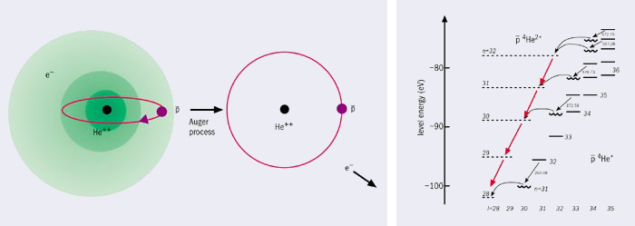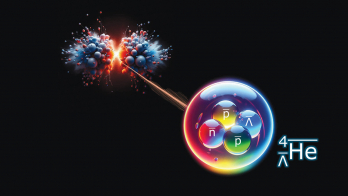The antiproton may soon be better known than the proton, and an ion that is more hydrogen-like than hydrogen may become the subject of high-precision laser spectroscopy experiments. John Eades describes an exotic future.

For some years now, the Japanese-European ASACUSA collaboration at CERN has been tightening the limit on the antiproton charge (Q) and mass (M) relative to the values for the proton. Any difference, however small, would indicate that the CPT-theorem, which under certain axiomatic conditions guarantees identical properties and behaviour for matter and antimatter, is in some way deficient. Such an eventuality would be of earth-shattering importance for our understanding of the physical world.
The latest result from ASACUSA is that any proton-antiproton charge or mass difference must be smaller than one part in 108 (Hori et al. 2003). As in the past, this limit was obtained by combining the ratio of the proton and antiproton Q/M values with their Q2M values. The former was obtained from previous measurements by the Harvard group of the proton and antiproton cyclotron frequencies in a Penning trap (Gabrielse et al. 1999), and the latter from the frequencies of laser-stimulated transitions in antiprotonic helium – that is, atomic helium in which an antiproton replaces one of the two orbiting electrons.
The improved precision was made possible through the use of a radiofrequency quadrupole decelerator to reduce the kinetic energy of antiprotons from the Antiproton Decelerator (AD) from 5.3 MeV to 65 keV. The lower energy ensured a much smaller variation in the position at which the antiprotons came to rest in low pressure (1 mb), low temperature (10 K) helium gas. This in turn allowed an adequate number of antiprotonic helium atoms to be formed in a volume small enough to be irradiated by the laser beams. Much of the art of high-precision experimentation lies in accounting for minute systematic errors, and in such a low-density environment systematic shifts in the resonant laser frequencies associated with collisions between “antiprotonic” and “ordinary” helium atoms could be better estimated and corrected for.
Further experiments completed in 2003 are about to bring another exciting new prospect into sight. These experiments showed that it is possible to create antiprotonic helium ions – with a single antiproton rather than a single electron orbiting the helium nucleus – in a state suitable for the kind of laser spectroscopy described above. The important thing here is that this pbarHe++ ion is a two-body system, while the neutral atom pbarHe++e– comprises three bodies. The properties of two-body systems are in principle exactly calculable mathematically, while those of three-body systems can only be solved approximately using extremely complex calculations with powerful computers. The results of these calculations are consequently subject to their own errors, which beyond a certain level of precision can exceed those of the experimentally determined resonant laser frequencies. This sets a practical limit to the precision that is available with the neutral antiprotonic helium atom – which may indeed be reached after ASACUSA returns to the fray in 2004 with a new, higher precision laser system.
By performing experiments on the two-body ion instead of the neutral atom, this calculational roadblock can be circumvented. The experiments will be difficult, not least because the frequencies involved lie in the vacuum ultraviolet spectral region. What makes the game worth playing is that the pbarHe++ ion is the nearest thing to the standard Bohr atom that is used to introduce undergraduate students to the concepts of atomic physics that physicists have ever had at their disposal. In many respects it is even more like hydrogen than the hydrogen atom itself. This is because the antiproton is non-relativistic and its de Broglie wavelength is some 40 times smaller than the Bohr radius, so that the semiclassical approximation, which is rather poor for normal, ground-state hydrogen atoms, turns out to be excellent for antiprotonic helium ions. All this means that the spin-independent contributions to the energy levels can literally be calculated on the back of an envelope to a few parts in 109. For comparison, in the 2p-state of atomic hydrogen, relativistic corrections appear at the 10-5 level and quantum electrodynamic corrections at 10-6.
At the same time, even experiments with the “conventional” neutral antiprotonic atom may lead ASACUSA into a fascinating new regime in 2004. If we assume CPT-invariance, we can relate the mass of the antiproton to the electron mass instead of the proton mass. If ASACUSA is able to achieve a precision some 40 times better than the current 10 ppb, then the antiproton will become an even better known fundamental particle than the proton itself. This seemingly paradoxical situation comes about because no “protonic antihelium” counterpart to the antiprotonic helium atom is available with which the corresponding proton experiments could be made.

In the proton case, the limit on the charge neutrality of bulk matter has to be combined with the ratio of proton and electron cyclotron frequencies, ωP and ωe measured in the same Penning trap. While the charge neutrality limit is phenomenally precise (parts in 1020), small corrections have to be applied to the measured ratio ωP/ωe because the two frequencies differ in magnitude by the large factor of the proton/electron mass ratio. One important consequence of this is that relativistic corrections, negligible for the proton, must be applied to the electron value. Taking this into account severely limits the precision obtained for the proton mass to about 0.5 ppb.
At this point we are confronted by some rather deep questions concerning the meaning of experimental results. In measuring any given quantity, we are really making a comparison with some arbitrarily chosen prototype object. The significance of that measurement, however, depends on the question we are trying to get nature to answer. It should be no surprise that when asking questions about fundamental particles, neither a block of platinum-iridium in Paris (the standard kg) nor a current-carrying wire loop (defining the MeV/c2) is a particularly useful prototype object. Of much greater interest are the values of particle properties with respect to those of other particles, these being the prototypes chosen, in a sense, by nature herself. Thus, choosing the proton as the prototype for the antiproton is clearly meaningful when asking questions about CPT invariance. Choosing the basic leptonic constituent of stable matter, the electron, as a prototype for the mass of the proton – the basic hadronic constituent – evidently has some fundamental significance in the larger picture of particle physics. Plausible though this choice may be, no theoretical basis yet exists within the Standard Model to predict what the hadron/lepton mass ratio should be.
If ASACUSA achieves the expected new precision for this ratio with the antiproton, it will then still be necessary to wait until some theoretical prediction arrives to put the result in the wider general context. We might also suggest that experimentalists find some way of doing a better job on the proton mass!








